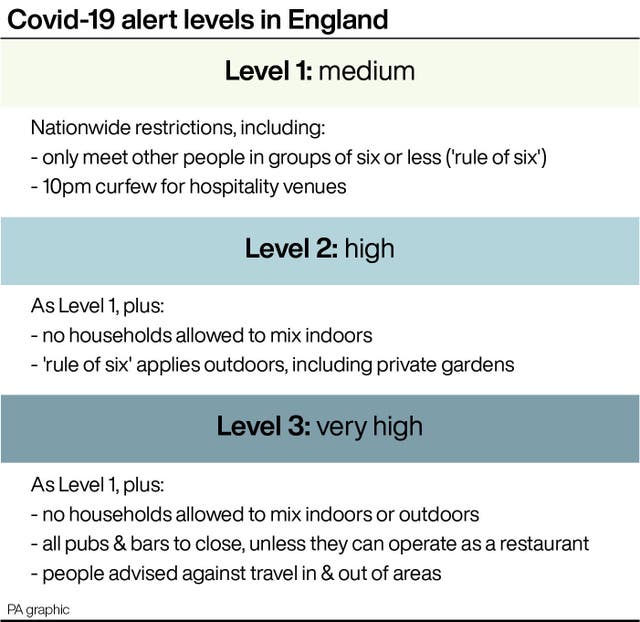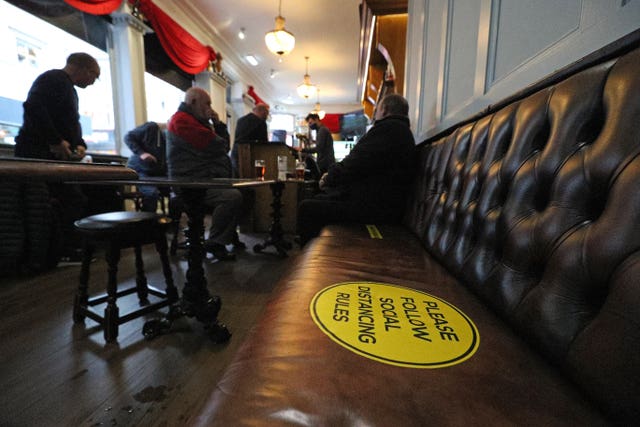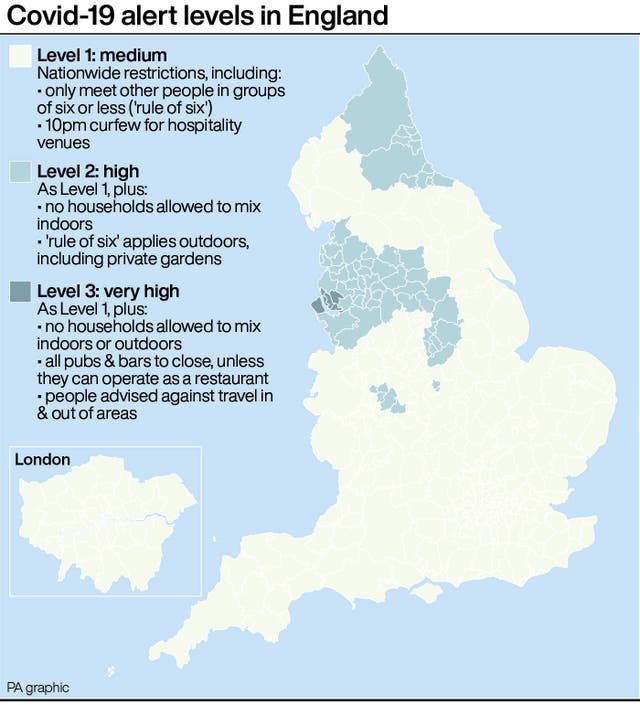The three-tier Covid restrictions: Key questions answered
The system will replace legislation on local lockdowns.

A new three-tier strategy of local lockdown measures for England has been announced by Boris Johnson in efforts to curb rising Covid-19 rates.
The Prime Minister told the Commons on Monday that this will “simplify and standardise” local lockdown rules.
– What is the new system?
Different areas of England will be split up into medium, high and very high alert levels.
– Will areas classed as medium see any changes?
These areas will be subject to the same national measures which currently apply across the country.
These include the 10pm curfew for pubs and restaurants and a ban on most gatherings of more than six people.

Household mixing is banned indoors, although support bubbles will still be permitted, while the rule of six will continue to apply outdoors.
Most areas which are already subject to local restrictions will move to this level, according to the Prime Minister.
Nottinghamshire, East and West Cheshire and a small area of High Peak will also move into the high alert level, he added.
– And the very high alert level?
Social mixing will be banned both indoors and in private gardens, while pubs and bars will be told to close unless they can operate as a restaurant.
Local leaders will help to determine whether other venues should be closed, such as gyms or casinos, in very high alert level areas.
People will also be advised against travel in and out of the areas.
– What will pubs in these areas be able to serve?
In areas where premises could only remain open as restaurants, officials said the expectation was that drinks could only be served with a substantial meal – a bag of crisps would not suffice.
The proposed legislation uses the term “table meal”, saying alcohol can only be sold as part of one which “might be expected to be served as the main midday or main evening meal”.
– Will schools or shops be shut at any level?
No. Schools, non-essential retail and universities will remain open in all levels, according to Downing Street.
– What will happen for Remembrance Sunday?
One of the 14 exceptions written into the rules regarding “very high” areas include an exception for events commemorating those who served the country during war.
This exception allows people, whether members of the Armed Forces, veterans or spectators, to gather so long as a risk assessment has been carried out and “reasonable measures to limit the risk transmission of the coronavirus” is carried out.
This exception also applies in “medium” and “high” areas.

The Liverpool City Region faces the toughest local lockdown restrictions and will move into the very high alert level from Wednesday, the Prime Minister told the Commons.

Indoor gyms and fitness studios will close, as well as sports facilities, leisure centres, betting shops, adult gaming centres and casinos, while wedding receptions will not be permitted, according to Downing Street.
– What about in Greater Manchester?
Greater Manchester has avoided being placed under the harshest lockdown measures, according to local MPs and the region’s mayor.
MPs were briefed by Health Secretary Matt Hancock on Monday that the 10 boroughs would be placed under high alert level restrictions, meaning they will operate under measures similar to those in place now.
Pubs serving food will be permitted to stay open, but households will be banned from mixing indoors.
– Which other areas are in the high alert level?
Parts of Lancashire have been placed in the second tier of coronavirus restrictions, including Blackpool, Preston, Blackburn with Darwen and Burnley.
In West Yorkshire, Leeds, Bradford, Kirklees, Calderdale and Wakefield are now at high alert level, while in South Yorkshire, Barnsley, Rotherham, Doncaster and Sheffield will also be subject to restrictions.

In the West Midlands, Birmingham, Sandwell, Solihull, Wolverhampton and Walsall have all been placed in the second tier, as has Leicester and Oadby and Wigston.
Warrington has also been placed in the high alert level.
– What happens next?
MPs will debate and vote on the measures on Tuesday and the new tiered system will come into effect on Wednesday.
The introduction of the measures will also see the revocation of previous local lockdown measures which were introduced in the West Midlands and north of England.
Measures are to be kept under review, and the secretary of state will review Tier 2 areas at least once a fortnight, and restrictions under Tier 2 once every 28 days.
There will be a four-week sunset clause for areas facing the toughest restrictions.





